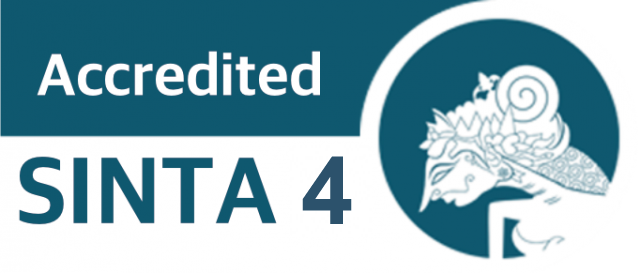PENGUJIAN KARAKTERISTIK FUNCTIONAL SUITABLITY DAN PERFORMANCE EFFICIENCY APLIKASI AUGMENTED REALITY MENGENAL TOKOH WAYANG SASAK
Abstract
An application product is said to be of quality if it meets the standards required by an internationally agreed organization. ISO 25010 is an international organization that issues standards to measure the suitability quality of an application or software developed by individuals or organizations. Getting to Know Wayang Sasak Characters is a software product designed as an Android-based augmented reality application. Therefore, the application Getting to Know Sasak Wayang Figures needs to be evaluated to determine its quality and suitability. This article aims to convey two test results of the characteristics contained in ISO 25010, namely functional suitability and performance efficiency. Functional suitability characteristics were tested using the black box method. The data collection technique was carried out using test cases. The results of the test case data processing are then calculated using the feature completeness matrix. Next, for performance efficiency characteristics, calculate the distance of the marker to the smartphone camera with the help of a ruler. Next, to find out the performance during the initial launch of the application, use the Firebase Lab Test tool. Test results for functional suitability characteristics, based on the feature completeness matrix, obtained a result of X = 0.87. These results show that the Getting to Know Sasak Wayang Characters application can run optimally even though there are still several features that are not functioning as expected. The results of performance efficiency testing by measuring market distance can detect markers up to 80 cm. The initial launch time for the application was obtained in 45 seconds using the Firebase Lab tools. The results of this research can then be used as a reference for developing the Getting to Know Sasak Wayang Characters application.
References
[2] W. Ustyannie dan T. W. Sari, “Analisis Kualitas Ap-likasi Augmented Reality Untuk Museum Sandi Ber-dasarkan Standar ISO 25010,” dalam Seminar Multi-media & Artificial Intelligence, 2021, hlm. 1–9. Di-akses: 20 Mei 2024. [Daring]. Tersedia pada: http://papersmai.mercubuana-yogya.ac.id/index.php/smai/article/download/104/79
[3] F. Arici, P. Yildirim, Ş. Caliklar, dan R. M. Yilmaz, “Research trends in the use of augmented reality in science education: Content and bibliometric mapping analysis,” Comput. Educ., vol. 142, hlm. 103647, 2019.
[4] M. Nurkhafid dan M. Mustagfirin, “PENERAPAN AUGMENTED REALITY PADA APLIKASI ‘PANDUKAWAN’(PENGENALAN WAYANG PANDAWA DAN PUNAKAWAN),” J. Inform. Dan Rekayasa Perangkat Lunak, vol. 1, no. 1, 2019, Di-akses: 20 Mei 2024. [Daring]. Tersedia pada: https://publikasiilmiah.unwahas.ac.id/index.php/JINRPL/article/view/2763
[5] S. Triono, V. Tulenan, dan S. D. E. Paturusi, “Ap-likasi Augmented Reality Pengenalan Tokoh Wayang Kulit Dengan Metode Markerless,” J. Tek. Inform., vol. 16, no. 3, hlm. 293–302, 2021.
[6] S. Kasim, “Bentuk Wayang Menak Sasak Di Lombok Tengah,” J. Sangkareang Mataram, vol. 4, no. 3, hlm. 60–62, 2018.
[7] A. B. Lazuardi, P. Pawito, dan A. Satyawan, “Per-forming Arts as Communication: The Traditional Media of Wayang Sasak in Digital Era,” Int. J. Mul-ticult. Multireligious Underst., vol. 7, no. 7, hlm. 121–128, 2020.
[8] N. Wilis, A. A. Zulfahmi, S. Budi, dan R. Prasasti, “Analisis Kualitas Aplikasi Psikotes Menggunakan Model ISO/IEC 25010,” SITEKIN J. Sains Teknol. Dan Ind., vol. 19, no. 1, hlm. 55–60, 2021.
[9] R. D. Dako dan W. Ridwan, “Pengujian karakteristik Functional Suitability dan Performance Efficiency tesadaptif. net,” Jambura J. Electr. Electron. Eng., vol. 3, no. 2, hlm. 66–71, 2021.
[10] W. Ustyannie dan T. W. Sari, “Analisis Kualitas Ap-likasi Augmented Reality Untuk Museum Sandi Ber-dasarkan Standar ISO 25010,” dalam Seminar Multi-media & Artificial Intelligence, 2021, hlm. 1–9. Di-akses: 20 Mei 2024. [Daring]. Tersedia pada: http://papersmai.mercubuana-yogya.ac.id/index.php/smai/article/download/104/79
Copyright (c) 2024 TEKNIMEDIA: Teknologi Informasi dan Multimedia

This work is licensed under a Creative Commons Attribution-ShareAlike 4.0 International License.
Semua tulisan pada jurnal ini menjadi tanggungjawab penuh penulis. Jurnal Teknimedia memberikan akses terbuka terhadap siapapun agar informasi dan temuan pada artikel tersebut bermanfaat bagi semua orang. Jurnal Teknimedia dapat diakses dan diunduh secara gratis, tanpa dipungut biaya, sesuai dengan lisensi creative commons yang digunakan.

Jurnal TEKNIMEDIA : Teknologi Informasi dan Multimedia is licensed under a Lisensi Creative Commons Atribusi-BerbagiSerupa 4.0 Internasional


.png)





